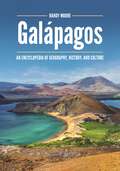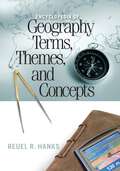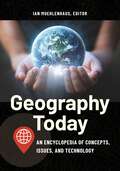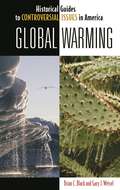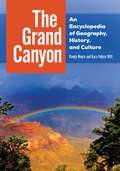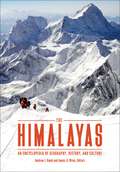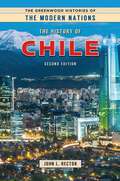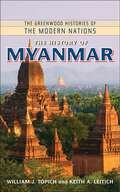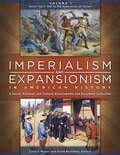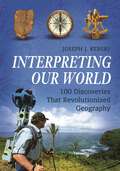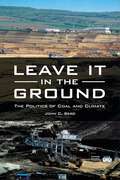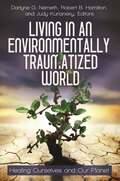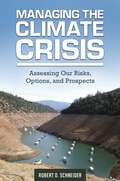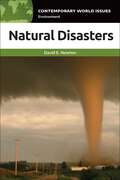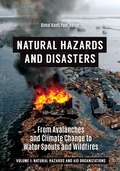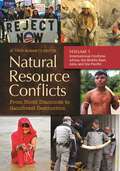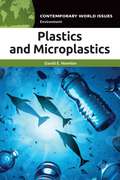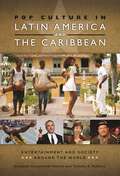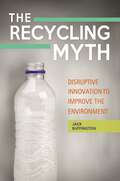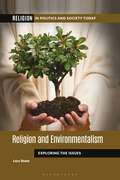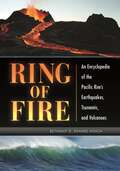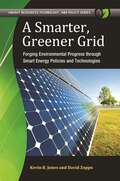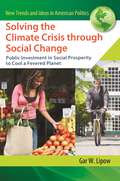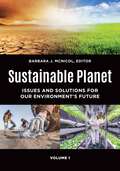- Table View
- List View
Galápagos: An Encyclopedia of Geography, History, and Culture
by Randy MooreThis encyclopedia provides readers with a comprehensive look at the Galápagos Islands, from the wildlife and scientists that made them famous to the challenges and issues the islands face today.In the mid-1800s, the Galápagos Islands served as Charles Darwin's playground, a volcanic archipelago where he famously worked on his theories of evolution and natural selection. But who actually discovered the islands? Why didn't any country claim them for more than 200 years? And is ecotourism hurting or helping these mysterious islands?This volume explores the history, science, and culture of the Galápagos Islands. A Preface, Introduction, Chronology, and Galápagos at a Glance primer introduce readers to the islands that are so famously associated with Charles Darwin. Twelve thematic essays allow readers to explore such topics as evolution, the geology of the islands, invasive species, and tourism in depth. Topical entries follow, covering key individuals and organizations as well as other important concepts and ideas.Thirteen primary document excerpts allow readers to study firsthand accounts from explorers and visitors to the islands. Appendices, a glossary, a bibliography, and sidebars round out the text. Students of history, geography, and science will find this volume informative, while general readers will be intrigued to learn about these unique islands.
Encyclopedia of Geography Terms, Themes, and Concepts
by Reuel R. HanksThis text provides an essential reference handbook for students of geography and related social sciences.How did the Greek geographer Eratosthenes make an accurate calculation of the earth's circumstance more than 1,500 years before the first voyage of Columbus to the New World? What are the "green belts" of England that dominate its rural landscape? And what is regarded as the driest continent on the planet?This handbook offers a broad coverage of terminology and concepts, serving as both an encyclopedic dictionary of geography terms and an approachable overview to the human and physical aspects of world geography. Approximately 150 geographic terms and concepts are defined and discussed, providing an accessible reference for anyone who requires a deeper knowledge of the language and ideas that are important to geography as a discipline. Helpful sidebars are provided to shed light on unusual or controversial theories and concepts. All major geographic concepts and terms are addressed and comprehensively explained using examples.
Geography Today: An Encyclopedia of Concepts, Issues, and Technology
by Ian MuehlenhausGeography Today provides a thoughtful and thorough introduction to the study of geography—from maps and technology to the study of different cultures, political systems, and economies, and an investigation of plate tectonics and climate systems.Geography Today: An Encyclopedia of Concepts, Issues, and Technology approaches the study of geography by concept, in contrast to most other works, which are organized by world region. Geography curriculums have been moving away from teaching the topic on a regional basis and toward teaching it through broader concepts. This is modeled by the National Geography Standards, the National Council for Geographic Education's Roadmap for 21st Century Geography Education, Texas Essential Knowledge and Skills Resource System, and ABC-CLIO's own geography advisory board, comprised of high school geography teachers from across the United States. By introducing geography concepts, Geography Today sets the foundation for readers to understand why certain geographies may be the way they are. It further helps high school geography students to apply concepts to different contexts with 101 geography terms, themes, and concepts for quick-reference research and study.
Global Warming (Historical Guides to Controversial Issues in America)
by Brian C. Black Gary J. WeiselTracing scientific ideas about the structure of Earth, Global Warming creates an intellectual portrait of the shifts in thinking that have led to the current controversy, enabling readers to make up their own minds on this important issue.Global Warming takes one of the hot-button issues of our time and surveys it in historical context, creating an intellectual portrait of the multi-century shifts in thinking that have led to gradual acceptance of the concept. The book summarizes pertinent aspects of geology, earth science, and climate science in easy-to-read terms. It then frames this background in terms of cultural and social shifts, including the Industrial Revolution, conspicuous consumption, and modern environmentalism. In addition, a study of the ebb and flow of cultural and political reception relates the issue to religious and social ideas.The information presented here will enable the reader to understand the scientific case stating that human activity has caused an unprecedented warming in the late 20th and early 21st centuries. Technical and political objections to this thesis are also covered, so that readers may form their own opinions on this critical subject.
The Grand Canyon: An Encyclopedia of Geography, History, and Culture
by Randy Moore Kara Felicia WittThis single-volume encyclopedia examines the Grand Canyon in depth, from the native peoples who have survived there for centuries to the explorers who charted its vast expanses and to the challenges that Grand Canyon National Park faces.The Grand Canyon is one of the most internationally recognized landscapes and symbols of nature in North America. In this one-volume encyclopedia, readers can dive into the many people, places, stories, and issues associated with the Grand Canyon as well as the scientific, religious, and social contexts of events that have made the Grand Canyon what it is. At the front of the encyclopedia are thematic essays that examine the Grand Canyon's history, geography, and culture. Essays cover topics including John Wesley Powell, to whom the Grand Canyon "belongs," the Native Americans who live at the Grand Canyon, and the future of the Grand Canyon. Following the thematic essays are approximately 150 topical entries focusing on more specific aspects of the Grand Canyon, such as trails and camps, natural formations, and courageous heroes as well as shameless profiteers who have influenced the Grand Canyon's history. The encyclopedia is rounded out by a chronology of human history at the Grand Canyon, a Grand Canyon "at a glance" section, and multiple fact-based sidebars. Through the people, places, and stories explored in this work, readers will gain a better understanding of how the history of the Grand Canyon is relevant to the world today.
The Himalayas: An Encyclopedia of Geography, History, and Culture
by Andrew J. Hund and James A. WrenA thorough and detailed resource that describes the history, culture, and geography of the Himalayan region, providing an indispensable reference work to both general readers and seasoned scholars in the field.The Himalayas: An Encyclopedia of Geography, History, and Culture serves as a convenient and authoritative reference for anyone exploring the region and seeking to better understand the history, events, peoples, and geopolitical details of this unique area of the world. It explores the geography and details of the demographics, discusses relevant historical events, and addresses socioeconomic movements, political intrigues and controversies, and cultural details as to give an overarching impression of the region as a coherent and cohesive whole. Readers will come away with a vastly heightened understanding of the geographical region we recognize as the Himalayas, and grasp the issues of geography, history, and culture that are central to contemporary understandings of the human culture in the region.The alphabetically arranged and succinct entries provide easy access to detailed, authoritative information. Additionally, sidebars throughout the book relate compelling facts that point readers to new and interesting avenues of exploration. The volume also includes a chronological overview of the region, ten primary source documents, and a comprehensive bibliography of supporting works.
The History of Chile (The Greenwood Histories of the Modern Nations)
by John L. Ph.D.This accessible chapter book, ideal for students and general readers alike, examines the political, social, and cultural history of Chile.Updated and revised from its 2003 edition, The History of Chile serves as a foundational text for those studying and interested in learning about this South American nation. Eleven chronologically-arranged chapters will guide readers through Chilean history, from prehistory to present day. Chapters examine topics such as the origins of Chileans, Chile's period as a Spanish colony, Augusto Pinochet's rule, the country's transition to democracy, and today's challenges in 2018–2019. A timeline, glossary, and appendix of Notable Individuals in the History of Chile round out the text.Written for high school and undergraduate students, but accessible to general readers as well, this volume examines Chile's history through the lenses of politics, economics, and culture and society. Readers will gain a better understanding of how Chile has modernized its economy and is incorporating immigrants.
The History of Myanmar (The Greenwood Histories of the Modern Nations)
by William J. Topich Keith A. LeitichThis text provides a thorough examination of the history of Myanmar from Neolithic times to the present.Myanmar has experienced a seemingly endless series of conquerors, dating from prehistoric times through the reign of Kublai Khan's Mongol forces beginning in the late 1200s, all the way through the modern era, when it was subject to both British colonial control and invasion by the Japanese during World War II.The History of Myanmar provides a detailed, historical overview of the key people, places, and events in this often-overlooked country's past and present. It examines the history of Myanmar, from Neolithic times to all of its ruling dynasties to the modern era in a chronological manner, providing a contextual framework for the further exploration of its complex history. This text pays special attention to the unique circumstances that led to the formation of the modern nation of Myanmar.
Imperialism and Expansionism in American History [4 volumes]: A Social, Political, and Cultural Encyclopedia and Document Collection [4 volumes]
by Chris J. Magoc and David Bernstein, EditorsThis four-volume encyclopedia chronicles the historical roots of the United States' current military dominance, documenting its growth from continental expansionism to hemispheric hegemony to global empire.This groundbreaking four-volume encyclopedia offers sweeping coverage of a subject central to American history and of urgent importance today as the nation wrestles with a global imperial posture and the long-term viability of the largest military establishment in human history. The work features more than 650 entries encompassing the full scope of American expansionism and imperialism from the colonial era through the 21st-century "War on Terror."Readers will learn about U.S.-Native American conflicts; 19th-century land laws; early forays overseas, for example, the opening of Japan; and America's imperial conflicts in Cuba and the Philippines. U.S. interests in Latin America are explored, as are the often-forgotten ambitions that lay behind the nation's involvement in the World Wars. The work also offers extensive coverage of the Cold War and today's ongoing conflicts in Iraq, Afghanistan, Africa, and the Middle East as they relate to U.S. national interests. Notable individuals, including American statesmen, military commanders, influential public figures, and anti-imperialists are covered as well. The inclusion of cultural elements of American expansionism and imperialism—for example, Hollywood films and protest music—helps distinguish this set from other more limited works.
Interpreting Our World: 100 Discoveries That Revolutionized Geography
by Joseph J. KerskiThis important book demonstrates why geography matters in the modern-day world through its examination of 100 moments throughout history that had a significant impact on the study of geography—literally, "writing about the earth."Geography is not simply accounts of the lands of earth and their features; it's about discovering everything there is to know about our planet. This book shows why geography is of critical importance to our world's 21st-century inhabitants through an exploration of the past and present discoveries that have been made about the earth. It pinpoints 100 moments throughout history that had a significant impact on the study of geography and the understanding of our world, including widely accepted maps of the ancient world, writings and discoveries of key thinkers and philosophers, key exploration events and findings during the Age of Discovery, the foundations of important geographic organizations, and new inventions in digital mapping today.The book begins with a clear explanation of geography as a discipline, a framework, and a way of viewing the world, followed by coverage of each of the 100 discoveries and innovations that provides sufficient background and content for readers to understand each topic. The book concludes with a concise synopsis of why it all matters and a look forward to 10 possible future discoveries in the next 50 years of geography. Students will gain a clear sense of what is truly revolutionary about geography, perhaps challenging their preconceived notion of what geography actually is, and grasp how important discoveries revolutionized not only the past but the present day as well.
Leave It in the Ground: The Politics of Coal and Climate
by John C. BergEmploying scientific explanations and hard data, this book shows why coal is such a problem, how the pro-coal forces got to be so powerful, and how those forces might be defeated through political activism.Coal provided the energy to build modern civilization. This energy source raised standards of living, multiplied the earth's population, and enabled people in developed countries to enjoy leisure time. Today, we know that if we burn all the coal available, climate change will continue to increase. But the use of coal isn't purely an environmental issue; there are also political and economic forces at play. This book examines the politics and environmental impact of coal production and distribution, presenting a clear point of view—that we must shift away from coal use—backed by hard data and supplying specific prescriptions for opposing and regulating the coal industry.Author John C. Berg explains how ending the burning of coal (and of oil and natural gas) is a political problem rather than a technical one; explodes the "clean coal" myth, providing scientific documentation of how burning coal emits more greenhouse gases per unit of energy than any other fuel; and describes how controlling coal use in the United States will also serve to restore the possibility of a meaningful international climate agreement. Additionally, readers will understand the critical importance of activism—from local to international—in spurring government regulation to control the coal industry, which can only be defeated politically.
Living Green: Your Questions Answered (Q&A Health Guides)
by Amy Hackney BlackwellThis book makes "green living," as it relates to teens and young adults, an approachable subject. The information and resources it comprises make it valuable for anyone who is interested in living a more sustainable and environmentally friendly life.Our actions have a powerful impact on the environment: how we heat and cool our homes, the types of cars we drive, and even the foods we consume all contribute to the health of the planet. Living Green: Your Questions Answered, an installment in Greenwood's Q&A Health Guides series, provides clear, concise answers to readers' questions about living a more eco-conscious life. In addition to explaining fundamental concepts such as carbon footprint, climate change, and sustainability, this book offers practical steps readers can take in their everyday lives to reduce their environmental impact across a number of areas, including energy usage, transportation, food and water, and even fashion and personal care products.Each book in this series follows a reader-friendly question-and-answer format that anticipates readers' needs and concerns. Prevalent myths and misconceptions are identified and dispelled, and a collection of case studies illustrates key concepts and issues through relatable stories and insightful recommendations. The book also includes a section on health literacy, equipping teens and young adults with practical tools and strategies for finding, evaluating, and using credible sources of health information both on and off the internet—important skills that contribute to a lifetime of healthy decision-making.
Living in an Environmentally Traumatized World: Healing Ourselves and Our Planet (Practical and Applied Psychology)
by Darlyne G. Nemeth Robert B. Hamilton Judy Kuriansky João Lucilio Ruegger de Albuquerque Gloria Alvernaz Mulcahy Robert A. Muller Donald F. Nemeth Anna T. Onishi Yasuo Onishi Alexander P. Steger L. Taighlor Whittington Susan ZelinskiThis book follows environmental changes—including those caused by human actions, as well as those resulting from natural circumstances—and provides a process to manage their impact on the future.Whenever environmental damages are caused by natural or human-made events, there are long-term effects for people. This eye-opening and unprecedented book explains the ongoing turmoil in the environment, while presenting ways to alleviate its effect on humankind's physical and mental health. Living in an Environmentally Traumatized World: Healing Ourselves and Our Planet discusses recent environmental events and examines the reasons why the resulting changes are inevitable. The authors assert that people experience six universal stages when they suffer from environmental trauma: shock, survivor mode, basic needs, awareness of loss, spin and fraud, and resolution. The book presents coping strategies for navigating negative ecological shifts, and provides a plan of action for responsibly managing our environment. Additionally, profiles of indigenous people who endure under environmental adversity provide real world examples of survival.
Managing the Climate Crisis: Assessing Our Risks, Options, and Prospects
by Robert O. SchneiderUsing a risk management approach to tease apart the complex issue of climate change, this book assesses the key vulnerabilities and redirects the discussion to present a comprehensive plan to overhaul our response to climate change.According to the 2014 U.S. Climate Report, temperatures might increase by 5 degrees even with aggressive strategies to reduce greenhouse gas emissions and could increase by as much as 10 degrees if emissions continue unabated. The report also predicts increases in extreme weather caused by global warming will continue. It is time to apply the lessons of sustainable disaster mitigation and hazard resilience to respond to the challenges posed by global warming, identify and assess the options we have for addressing the crisis, and create a practical plan for managing the problem.Unlike other books on climate change, this one uniquely applies a risk management approach to answer the question, "Considering what our policies look like now, what do we need to do next to mitigate climate change?" Robert O. Schneider, PhD, explains how the warming climate will affect everything from peak temperatures and weather extremes to infrastructure such as groundwater reservoirs, airports, and wastewater systems, making the dire nature of the crisis clear to readers in practical and personal terms. By enabling readers to understand the scientific and historical contexts of the climate crisis, the author makes a compelling case for the urgency of implementing a national climate policy to respond to the challenges posed by global warming.
Natural Disasters: A Reference Handbook (Contemporary World Issues)
by David E. NewtonThis book provides a detailed introduction to natural disasters and the ways in which they have had and continue to have, profound effects on human society.Natural Disasters: A Reference Handbook surveys the impact of these events on human civilization. The opening chapter provides a general history and background of the major types of natural disasters, including earthquakes, volcanic eruptions, severe storms, and forest fires. The information presented in this introduction allows the reader to better understand current issues, problems, and solutions related to natural disasters discussed in subsequent chapters.The book covers the role of natural disasters in human life from earliest recorded history (and, to some extent, even earlier) to the present day. It provides an extensive variety of resources that encourage readers to learn more about the topics discussed. The book is intended for readers in the late middle school to high school age range, as well as adults who may have a special interest in the subject.
Natural Hazards and Disasters [2 volumes]: From Avalanches and Climate Change to Water Spouts and Wildfires [2 volumes]
by Bimal Kanti PaulThis two-volume encyclopedia provides the science behind such heart-pumping geophysical hazards as volcanic eruptions, earthquakes, cyclones, and floods, as well as authoritative entries on notable natural disasters around the world and the agencies that help those they impact.Natural Hazards and Disasters explores the sometimes harsh effects of nature on human life. The set discusses the physical science behind specific types of hazards and disasters (such as blizzards and tsunamis), their impact on our lives, how damage is mitigated or prevented, recovery and reconstruction, and the current research and technology used for managing or even eliminating the hazards.Written by experts in the field, the set also explores a variety of extreme events from around the world, including the 2010–2011 Christchurch Earthquakes (New Zealand), the 2017–2018 Thomas Fire (United States), and the 2018 Kerala Floods (India). Also covered are the world's major international and nonprofit aid agencies, like the Salvation Army and Oxfam, that assist disaster victims.
Natural Resource Conflicts [2 volumes]: From Blood Diamonds to Rainforest Destruction [2 volumes]
by M. Troy BurnettNatural resource and environmental conflicts have long been issues confronting human societies. This case-based examination of a wide range of natural resource disputes exposes readers to many contemporary examples that offer reasons for both hope and concern.The Rwandan genocide, the Sudanese civil war, and perpetual instability in the Middle East and Africa: each of these crises have arguably been instigated and maintained by natural resource disputes. China has undertaken a Herculean task to plant hundreds of millions of trees along its margins in an effort to save Beijing from crippling dust storms and halt the expansion of the Gobi desert. Will it work, and is it worth it? These and many other cases of conflict stemming from natural resource or environmental concerns are explained and debated in this up-to-date examination of contemporary and ongoing topics. The book examines conflicts over precious resources and minerals, such as diamonds, oil, water, and fisheries, as well as the pursuit of lesser-known minerals like Coltan and other "rare earth elements"—important resources in our technological age—in remote locations such as Greenland and the Congo. Each topic contains an overview and two position essays from different authors, thereby providing the reader with highly informative and balanced perspectives. Reference entries accompany each topic as well, helping students to better understand each issue. As the world hurtles into the 21st century, these natural resource issues are becoming increasingly important, with all global citizens having a significant stake in how these conflicts arise and play out.
Plastics and Microplastics: A Reference Handbook (Contemporary World Issues)
by David E. NewtonPlastic plays a vital role in today's world but has become increasingly problematic. Plastics and Microplastics: A Reference Handbook discusses the history and evolution of plastic and its many uses, both in the United States and around the world.Beginning with a history of plastic—from the first scientific discovery of the material to its diversity of forms and uses in the present day—Plastics and Microplastics: A Reference Handbook discusses the history and evolution of plastic and its many uses, both in the United States and around the world. Importantly, it delves into the problems and controversies concerning plastic and microplastics, such as the pollution of oceans, rivers, and streams; its exceptionally long shelf life; its contribution to air pollution; and ingestion of microplastics by marine life.One of the most valuable aspects of the book is its survey of the history of plastics and microplastics conducted in a manner that helps readers to identify key issues to address. Moreover, it discusses both implemented and proposed solutions. A perspectives chapter includes a broad range of voices, allowing crucial, diverse perspectives to round out the author's expertise.
Pop Culture in Latin America and the Caribbean (Entertainment and Society around the World)
by Elizabeth Gackstetter Nichols Timothy R. Ph.D.This insightful book introduces the most important trends, people, events, and products of popular culture in Latin America and the Caribbean.In recent times, Latin American influences have permeated American culture through music, movies, television, and literature. This sweeping volume serves as a ready-reference guide to pop culture in Central America, South America, and the Caribbean, focusing on Mexico, Brazil, Venezuela, Argentina, Haiti, Cuba, the Dominican Republic, Jamaica, and Costa Rica, among other areas. The work encourages hands-on engagement with the popular culture in these places, making such suggestions as Brazilian films to rent or where to find Venezuelan music on the Internet.To start, the book covers various perspectives and issues of these regions, including the influence of the United States, how the idea of machismo reflects on the portrayal of women in these societies, and the representation of Latino-Caribo cultures in film and other mediums. Entries cover key trends, people, events, and products from the beginning of the 20th century to the present day. Each section gives detailed information and profound insights into some of the more academic—and often controversial—debates on the subject, while the inclusion of the Internet, social media, and video games make the book timely and relevant.
The Recycling Myth: Disruptive Innovation to Improve the Environment
by Jack BuffingtonThis book states the harsh truth: that despite best intentions, our current environmental practices are doing more harm than good, and that the solution lies in creating supply chains of the future that design, produce, consume, and reuse materials in a manner that is balanced economically and environmentally.One billion beverage containers are used on a daily basis in the United States, with at least 600 million of them ending up in landfills. Even the 400 million that are recycled—at a great cost—are not accomplishing the task of helping the environment. This economic and environmental catastrophe cannot be solved by recycling programs. From his experience as a leader in the American consumer beverage industry and a researcher in Sweden, author Jack Buffington has developed a transformational solution that seeks to not just mitigate the environmental damage but jumpstart the economy while actually achieving zero waste.The Recycling Myth tells the story of how our current environmental practices are unintentionally doing more harm than good and how we need to create a radically different supply chain of the future that must, as best as possible, copy the natural system of growth, decay, and regrowth, and discontinue a disastrous pattern of material design and use. Backed by irrefutable evidence, the book destroys our comfortable notions of the recycling status quo; explains why recycling will never work in the United States, despite decades of attempts; and introduces a new system that will actually work—without asking consumers to consume less.
Religion and Environmentalism: Exploring the Issues (Religion in Politics and Society Today)
by Lora StoneA foundational resource for readers investigating religiously motivated environmentalism, this book provides both a global overview of the subject and a detailed discussion of key figures, concepts, organizations, events, and documents.Beginning in the late 1960s, a growing number of activists, scholars, and scientists asserted that traditional religions had been major contributors to the environmental crisis. In response, theologians, religious organizations, and religiously motivated activists became increasingly involved in environmental issues. At the same time, emerging nature-based belief systems emphasized values and lifestyles based in environmentalism. More recently, religiously motivated environmentalism has become a powerful force in shaping environmental policy and human action globally and has joined with secular environmentalism to address related issues. This book explores the background and current state of religious environmentalism. The book begins with an overview essay examining the history and context of religious environmentalism and its significance today. A chronology then profiles the most important events related to religious environmentalism. A section of more than 50 alphabetically arranged reference entries follows, with each entry providing objective information about people, places, events, movements, works, and other topics. The entries include cross-references and suggestions for further reading, and the book closes with a selected, annotated bibliography of major works.
Ring of Fire: An Encyclopedia of the Pacific Rim's Earthquakes, Tsunamis, and Volcanoes
by Bethany D. HingaThe author examines natural disasters around the Pacific Rim throughout history together with scientific data context to produce enlightening—and highly readable—entries.On March 11, 2011, a magnitude 9.0 earthquake struck off Japan's coast, triggering a powerful tsunami. The massive destruction that resulted proved that not even sophisticated, industrialized nations are immune from nature's fury. Written to take some of the mystery out of the earth's behavior, this encyclopedia chronicles major natural disasters that have occurred around the Pacific Rim, an area nicknamed the "Ring of Fire" because of the volatile earth that lies above and below. The encyclopedia offers descriptions of deadly earthquakes, volcanic eruptions, and tsunamis through time. The entries provide in-depth information that promotes an understanding of the structure of the earth and earth processes and shares the insights of scientists whose work helps clarify the causes and effects of these cataclysmic events. At the same time, the work examines how the people and cultures of the Pacific Rim view this active part of the earth, how they live with the threat of disaster, and how they have been affected by major events that have occurred. Readers will come away with a holistic view of what is known, how this knowledge was gained, and what its implications may be.
A Smarter, Greener Grid: Forging Environmental Progress through Smart Energy Policies and Technologies (Energy Resources, Technology, and Policy)
by Kevin B. Jones David ZoppoThe pressing need for a smarter and greener grid is obvious, but how this goal should be achieved is much less clear. This book clearly defines the environmental promise of the smart grid and describes the policies necessary for fully achieving the environmental benefits of the digital energy revolution.The United States' electrical grid is an antique. It was built to serve a 20th-century economy and designed in an era when the negative environmental impacts of electricity production were poorly understood. It must be upgraded and modernized. The proposed solution is a "smart grid"—a network of new digital technologies, equipment, and controls that can respond quickly to the public's changing energy needs by facilitating two-way communication between the utility and consumers. This book explains the environmental benefit of a smart grid, examines case studies of existing smart grids, and identifies the legal and regulatory policy hurdles that must be overcome to fully realize the smart grid's benefits.Based on six diverse organizations' experience as "early adopters" in the digital energy revolution, the authors explore how a smart electric grid offers real promise for supercharging energy efficiency, democratizing demand response, electrifying transportation, preparing for ubiquitous distributed clean energy technologies, and automating the distribution system. Against the backdrop of climate change and continuing economic uncertainty, setting a path for environmental improvement and upgrading our electric grid with new digital technologies and associated smart policies is more critical than ever before.
Solving the Climate Crisis through Social Change: Public Investment in Social Prosperity to Cool a Fevered Planet (New Trends and Ideas in American Politics)
by Gar W. LipowThis book presents an accessible and easy-to-follow argument that the climate crisis is a side effect of inequality and injustice, and demonstrates how strategies such as large-scale social investment will prove far more effective in reducing greenhouse gas pollution than cap-and-trade or other forms of free-market environmentalism.Solving the Climate Crisis through Social Change: Public Investment in Social Prosperity to Cool a Fevered Planet offers a new approach to battling the climate crisis, arguing that the massive waste that caused the current environmental crisis resulted not only from fundamental structural flaws in markets but also from social inequality, lack of democracy, and a deeply flawed foreign policy. Rather than providing the typical doomsday perspective, it offers realistic optimism about the expanding climate crisis, highlighting the convergence between the necessary steps to save the planet and what needs to be done to improve the lives of Americans.The author's discussion of the United States's role in the climate crisis spans subjects as varied as the 17th-century forests of New England, the evolution of housework over 200 years, the American addiction to the automobile, the lettuce fields of California in the 1970s, and the Guano wars in 19th-century Bolivia, Chile, and Peru. This book will appeal to a wide range of readers, from the interested general public to students, academics, professionals, and other experts. The main section presents a clear and accessible survey of the economic, social, and political causes of the climate crisis, accompanied by potential solutions, while extensive appendixes offer in-depth and technical discussions.
Sustainable Planet [2 volumes]: Issues and Solutions for Our Environment's Future [2 volumes]
by Barbara J. McNicolSustainable Planet is a two-volume resource that provides comprehensive coverage on the world's most pressing environmental issues, their impact in countries around the world, and how—or if—they are being addressed.Sustainable Planet: Issues and Solutions for Our Environment's Future examines contemporary challenges to sustainability, including population, climate change, decreasing biodiversity, land degradation, and water quality. Each chapter analyzes one of these challenges by first providing an introduction to the topic as well as key concepts to provide readers with a basic understanding of the issue. Essays deepen comprehension by investigating different aspects of the challenge.Case studies written by experts in the field follow. Each case study considers how a specific country is affected by the particular issue as well as the measures the country is taking to find solutions that will provide for a more sustainable future. The final chapter of the book explores sustainability at a global level by examining, through annotated primary documents, a number of multinational initiatives and alliances intended to create a more sustainable planet.
